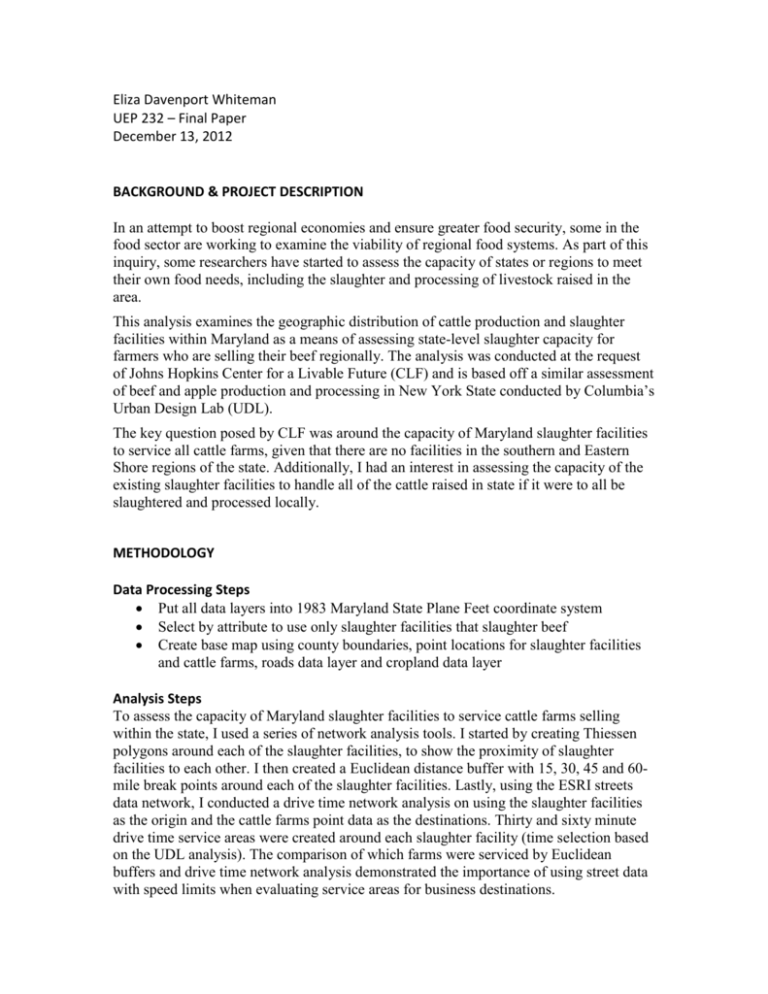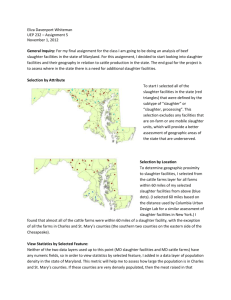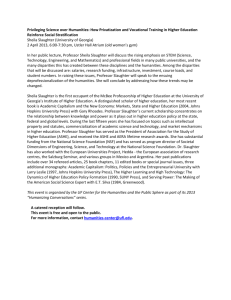Final Paper
advertisement

Eliza Davenport Whiteman UEP 232 – Final Paper December 13, 2012 BACKGROUND & PROJECT DESCRIPTION In an attempt to boost regional economies and ensure greater food security, some in the food sector are working to examine the viability of regional food systems. As part of this inquiry, some researchers have started to assess the capacity of states or regions to meet their own food needs, including the slaughter and processing of livestock raised in the area. This analysis examines the geographic distribution of cattle production and slaughter facilities within Maryland as a means of assessing state-level slaughter capacity for farmers who are selling their beef regionally. The analysis was conducted at the request of Johns Hopkins Center for a Livable Future (CLF) and is based off a similar assessment of beef and apple production and processing in New York State conducted by Columbia’s Urban Design Lab (UDL). The key question posed by CLF was around the capacity of Maryland slaughter facilities to service all cattle farms, given that there are no facilities in the southern and Eastern Shore regions of the state. Additionally, I had an interest in assessing the capacity of the existing slaughter facilities to handle all of the cattle raised in state if it were to all be slaughtered and processed locally. METHODOLOGY Data Processing Steps Put all data layers into 1983 Maryland State Plane Feet coordinate system Select by attribute to use only slaughter facilities that slaughter beef Create base map using county boundaries, point locations for slaughter facilities and cattle farms, roads data layer and cropland data layer Analysis Steps To assess the capacity of Maryland slaughter facilities to service cattle farms selling within the state, I used a series of network analysis tools. I started by creating Thiessen polygons around each of the slaughter facilities, to show the proximity of slaughter facilities to each other. I then created a Euclidean distance buffer with 15, 30, 45 and 60mile break points around each of the slaughter facilities. Lastly, using the ESRI streets data network, I conducted a drive time network analysis on using the slaughter facilities as the origin and the cattle farms point data as the destinations. Thirty and sixty minute drive time service areas were created around each slaughter facility (time selection based on the UDL analysis). The comparison of which farms were serviced by Euclidean buffers and drive time network analysis demonstrated the importance of using street data with speed limits when evaluating service areas for business destinations. 1. Thiessen polygons map to show proximity of slaughter facilities Generate Thiessen polygons 2. Euclidean distance buffer map Generate buffer around slaughter facilities with 15, 30, 45 and 60-mile break points to show how many farms each facility serves/which facilities are close to lots of farms 3. Service area polygons map using drive time analysis to show proximity of slaughter facilities to farms Use Network Analyst to create a drive time service area polygon to show drive time from slaughter facilities at 30-minute and 60-minute intervals Set up parameters for analysis, using 30 and 60 default breaks, do not allow U-turns, provide output in time and mileage Run to compute the service area Use Properties: Symbology to denote the areas that are closer in and farther away from the facilities Overlay farm locations to show how well each slaughter facility serves the farms 4. Origin-Destination network path analysis to show all farms within one hour drive time of slaughter facilities. Create an O-D cost matrix analysis layer to find the shortest route from each slaughter facility to each farm Add origins and destinations Set up parameters for analysis – no U-turns and results in time and distance (miles) Run to calculate O-D matrix Create summarize tables to find the average, minimum and maximum drive time and mileage to each slaughter facility. For those farms not within the one hour service areas, a closest facility network analysis was performed to show the shortest driving route (by time) from each farm to the closest slaughter facility. Median centers were also produced for these farms (one in the southern counties and one on the Eastern Shore) to determine the point representing shortest 3 Euclidean distance to all farms in the service area. These calculations can be used for assessing aggregation strategies for farms outside the service areas. 5. Closest Facility network analysis Select farms that are outside 60-minute drive time service area and create new layer Using this point layer, set parameters for analysis – no U-turns and results in time and mileage Run to determine shortest driving routes from each farm to its closest slaughter facility Create summarize table to see average, minimum and maximum drive time and mileage. 6. Median Center Use layer for farms outside of 60-minute drive time service area - select farms in southern counties and create new layer, then select farms in Eastern Shore counties and create new layer Use spatial statistics tool: Measuring geographic distribution – median center to determine median center for southern counties and for Eastern Shore counties Finally, a series of maps were created to show the distribution of beef cattle across the state by county using three different categories (cow/calf inventory, cattle on feed and cattle sold for slaughter). This data was gathered from the 2007 National Agricultural Census (NASS) and is not comprehensive for each county. 7. Distribution mapping for cattle production Join and relate NASS data using county FIPS codes for: o Beef cow/calf inventory (point-in-time) o Beef cattle on feed (point-in-time) o Cattle on feed sold for slaughter (annual) Add all values in quantities and display using quintiles 4 DATA LAYER/DATA SET Beef cattle per county: Cow/calf inventory Cattle on feed Cattle on feed sold for slaughter Current MD slaughter facilities Street Data with speed limit information SOURCE NASS - 2007 YEAR 2007 FORMAT CSV file NOTES Gives numbers for cattle raised on feed – no information for cattle raised purely on pasture. Does not have information for all counties. CLF 2012 Shapefile Location, services offered and weekly slaughter numbers. ESRI Street Network 2010 Cropland data layer for pasture/hay/alfalfa land Location of MD cattle farms that sell within MD Cropscape via CLF CLF Street Network Dataset Shapefile 2012 Shapefile Maryland County Outlines MD Dept. of Planning ESRI 2010 Shapefile 2010 Shapefile State Outlines This data was collected based on information from online farm listing databases. It is not comprehensive and does not necessarily align with NASS data for number of head of cattle on feed. CHALLENGES + LIMITATIONS To execute this project, it had been my hope to map the location and distribution of all cattle production in the state. Initially I had planned to join the NASS data with the farm data from CLF and distribute the cattle across the geocoded farms, but it became clear that joining these two datasets would create very misleading results. The CLF data layer includes the location of cattle farms in Maryland that sell within the state, but does not include all beef farms. The NASS data, on the other hand, is for cow/calf counts, cattle on feed and cattle on feed sold for slaughter by county, but not all counties are available. These two data sources are not necessarily correlated, since some of the farms in the CLF layer are likely grass-fed operations and are not a full count of all cattle farms in the state. I had also considered matching the cattle counts with the cropland data layer, but given that the cattle counts are for cattle on feed (meaning feedlots) it seemed unlikely that the cropland data would be an accurate representation of the true location of most cattle operations. Given these challenges I opted to just represent the distribution of cattle numbers within the state (by county) without joining these to the service area analysis using the CLF cattle farms data. This led to a somewhat less thorough analysis, than I had hoped, but ultimately served as a tool to show the limitations of conducting research using agricultural data in the U.S. 5 Data Limitations Farm-level data Geospatial analysis of farm production in the United States is challenging because of limited data availability. Due to privacy concerns, there is no farm-level data through NASS and counties with small levels of production also typically lack data. This poses a challenge for accurately representing the density of cattle production. While there is some farm-level information on cattle farms in Maryland (used in this analysis), the data is not comprehensive for the state, which makes accurately joining census data to farm locations problematic. Alternative livestock systems Assessing the production levels and slaughter capacity for alternative livestock systems poses another limitation for analysis. NASS collects data on cattle raised on feed (mostly in feedlots), but does not track numbers for cattle raised on pasture. This makes determining how well slaughter facilities are serving grass-fed producers challenging. Tracking cattle numbers Following the path of cattle through the production chain is difficult. NASS provides numbers for cow/calf operations, which are much higher in MD than cattle on feed or cattle sold for slaughter. This suggests many more cows are born in MD than are brought to full weight and slaughtered in state. Many cows born in MD are likely sent to other states in the Northeast or Midwest for backgrounding, finishing and slaughter. Given the gap between the number of cattle slaughtered yearly by the MD facilities and the number sold for slaughter, it is safe to assume that many of the cows slaughtered in MD facilities are from other states. Also, the cow/calf and cattle on feed data are point-in-time numbers, while the sold for slaughter is annual data, making these different measures difficult to compare. CONCLUSIONS The drive time analysis demonstrated that there are 10 southern and Eastern Shore counties in the state either partially or entirely outside any of the one-hour service areas for cattle slaughter facilities. While the bulk of cattle production (based on 2007 NASS data) is in the northern part of the state, where most of the slaughter facilities are, there are still significant areas of cattle production that lack adequate proximity to facilities. According to slaughterhouse managers in the state, the problem is not one of capacity to handle the number of Maryland cattle slaughtered in state (Table 1), but rather an issue of proximity to services. Instead of putting in additional facilities, it would make more sense to aggregate transportation of cattle from farms outside of service areas (using median center and closest facility calculations) so as to reduce drive time. 6 Table 1 The summary for drive time analysis (Table 2) shows that the minimum average drive time to each slaughter facility ranges from 70-219 minutes. The three facilities with the shortest average drive time are also the facilities with the largest capacity, suggesting that they are well located to service many of the farms used in this analysis. Two of the three slaughterhouses found in the closest facility analysis are also the facilities with by far the largest capacity in the state, which means they would likely be the best suited for taking on additional clients. Table 2 If I were to continue with this research or had more time to conduct it again, I would like to collect more data on grass-fed production in the state and would also like to have designed a better analysis to determine the point location of farms so as to more accurately distribute cattle density within the state. If this was combined with population and consumption data, we could get a more thorough analysis of Maryland’s capacity to cover its own cattle production, slaughtering and processing needs SIMILAR STUDIES Health -> Infrastructure, Columbia Urban Design Lab The primary study that I used as the basis for my project is the report put out by the Columbia University Urban Design Lab. This report is intended to look at the correlations between the obesity epidemic and our food system in the U.S. The researchers posit that a regional food systems approach will help to ameliorate the health crisis we are currently experiencing, by localizing our food supply and creating greater access to healthy, fresh foods. They argue that in order to draw more significantly on our 7 regional food supply resources, infrastructure (for slaughter, processing and transport) needs to be improved. The primary mapping analysis in their project looks at cattle production and slaughtering facilities in New York State. The final map is a weighted overlay of the optimal sites in the state of New York for siting additional slaughter facilities. This overlay includes cattle production density, slaughter facilities with one-hour drive time analysis to farms, and major urban areas (>50,000 population) with one- and three-hour drive time analysis to slaughter facilities. Mapping potential foodsheds in New York State This study, conducted by researchers from Cornell, examines the potential for New York State to meet all of its own food needs from within the state. The analysis was done by creating a spatial-optimization model. First they collected data to assess production capacity for agricultural land in New York, actual food yields, population density, and per capita food needs. They then used these datasets to create an optimization model that demonstrated production capacity to meet the needs of populated areas, while minimizing driving time. This study is only peripherally relevant to my project, as it is focused on yield potential and is looking at a much more comprehensive set of crops, rather than focusing specifically on the production and processing of one crop or animal. I thought that the evaluation of distance to population centers might provide useful insight, but they used Euclidian distances, which are not as accurate as the drive time analysis I conducted. Also, since they were working with data that expressed actual food needs, they were able to do a more nuanced optimization for assessing ideal distribution systems. Synthesized Population Databases: A Geospatial Database of US Poultry Farms This study looks at the siting of poultry farms in order to study infectious disease. While the focus of their research is quite different from mine, their methods for determining the location and size of poultry farms in the country were useful in understanding the options for analysis. They collected farm data from the Ag Census (number of poultry farm, farm types and size of operation by county). Then in order to determine the actual siting of the farms, they determined the primary factors that affect poultry farm location (via literature review) which they determined to be: 1. Zoning and local regulations 2. Available affordable land 3. Poultry industry infrastructure (hatcheries, slaughter facilities, etc.) 4. Physical constraints for siting poultry facilities (lakes, steep slopes, etc.) They then used these factors and various data layers to determine the likely location for poultry farms in the U.S. Following that they looked at actual poultry farm locations in order to quantify the importance of each of the determining factors as compared to the likelihood of finding a farm at any given location. 8 Farm Animal Demographics Simulator Aids in Disease Modeling This article was referenced in the previous study as a GIS methodology used for approximating livestock farm locations and numbers of animals per farm. The author of the poultry study points out that this method has several limitations, including having exaggerated farm density and overly large spatial distribution, but it does at least provide another specific technique for how to address the issue I faced in my analysis. In this model, a mask was created to determine where farms could be (i.e. not in waterways, parks, federal land, urban areas and within 300 meters of the road). The locations of the farms were then randomly assigned (with the correct number per county) using the “generate random points” tool. Because the Ag Census provides the number of farms per county, as well as the number of each size (by category) of farms and the total number of cattle per county, the researchers were then able to randomly assign a size category and a total number of cattle to each of the farm points in each county. This model does not provide a good suggestion for how to handle counties where the data is missing (which is an issue with the Maryland data). Additional Maps Sources: MD Department of Planning, ESRI, CLF Resources 9 Bruhn, M., B. Munoz, J. Cajka, G. Smith, R. J. Curry, D. K. Wagener, W. D. Wheaton. (2012). Synthesized Population Databases: A Geospatial Database of US Poultry Farms. RTI Press, MR-0023-1201. Research Triangle Park, NC: RTI Press. Conard, M., K. Ackerman, D. Gavrilaki. (2011). Infrastructure -> Health: Modeling production, processing and distribution infrastructure for a resilient regional food system. Urban Design Lab at The Earth Institute. New York, NY: Columbia University. Accessed at http://admin.urbandesignlab.columbia.edu/sitefiles/file/optimizationmodel.pdf. Geter, K. (2006). Farm Animal Demographics Simulator Aids in Disease Modeling. USDA, National Animal Health Surveillance System, Outlook, Quarter Two. Retrieved at http://nsu.aphis.usda.gov/outlook/issue10/outlook_apr06_fads.pdf. Peters, C., N. Bills, A. Lembo, J. Wilkins, & G. Fick. (2009). Mapping potential foodsheds in New York State: A spatial model for evaluating the capacity to localize food production. Renewable Agriculture and Food Systems, 24, 72-84. 10







